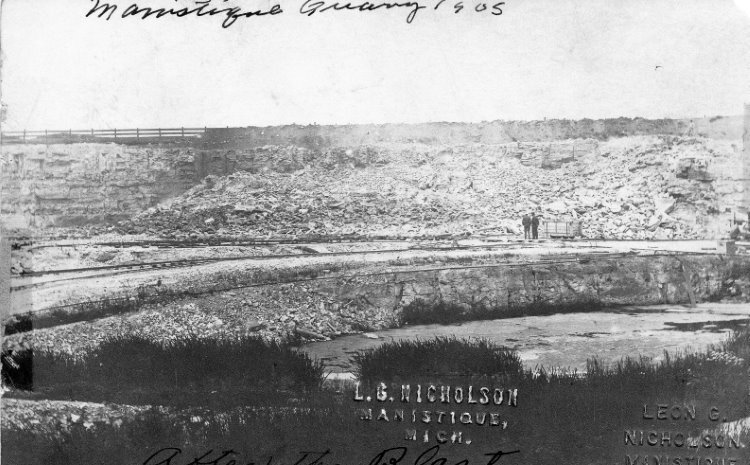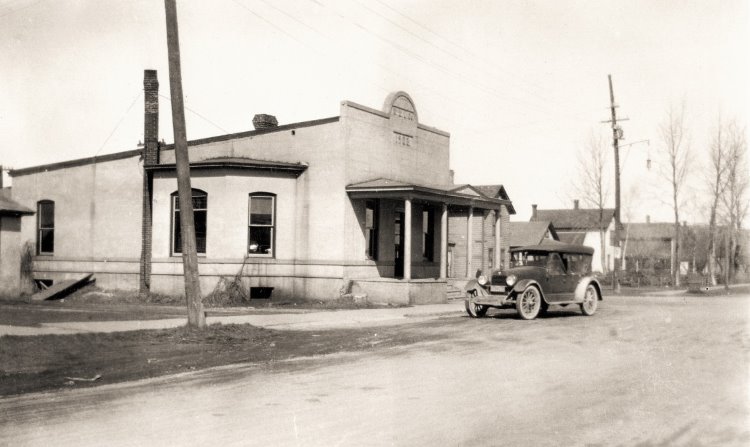
Blasting preparation at the WML company quarry in Manistique. Photo courtesy Gulliver Historical Society, Leon Nicholson collection.
The son of Irish immigrants, pioneer Manistique industrialist George Nicholson was born on February 8, 1852 in Hartford, Wisconsin. As a young man, Nicholson attended business school in Appleton, Wisconsin. His first venture into the world of commerce came in Graysville, Wisconsin, where he operated a general merchandise store. After relocating to Chilton, Wisconsin, he opened a clothing and dry goods store and also had interest in a grain elevator.
Nicholson married Elizabeth Gray of Harrison, Wisconsin, on Christmas day, 1876. It was in the early 1880s that Nicholson entered the lime business, becoming a partner in the Western Lime and Cement Company, growing in experience and expertise in this specialized field. During the winter of 1888, Nicholson explored the length of Wisconsin’s Door Peninsula on snowshoes looking for dolomite formations, before crossing Green Bay to Fayette and Garden in the Upper Peninsula.
Drawn finally to Manistique in 1889 by the presence of extensive dolomite deposits and the availability of slab wood fuel from three sawmills; Nicholson established the White Marble Lime Company. In 1889, Nicholson built a six kiln lime plant in Manistique which stood along the west side of the current quarry pool in Central Park. Two years later he built the two kiln plant at Marblehead east of Manistique. Dolomite limestone was burned and made into quicklime at both Manistique and Marblehead.
The process began in the quarries where dynamite was used to break up the limestone formations. An 800 foot long blast at the Manistique quarry in 1910 used 2,463 pounds of dynamite to loosen 9,850 tons of rock. Workers loaded five ton cars by hand and were paid $0.15 per ton. Crushed limestone was transported to the top of the kilns on elevated rails where the rocks were unloaded into the top of the kilns using manual labor. An intense fire on both sides of the bottom of the kilns “calcined” the limestone, transforming it into raw slate which became white powder when cooled. Lime was drawn from the bottom of the kiln at four hour intervals by men using steel hooks to extract the hot lime. It was marketed either in the form of raw slate, or it was hydrated by mixing water with powdered lime.

The limestone quarry at Manistique photo dated 1905. Photo courtesy Gulliver Historical Society, Leon Nicholson collection.
Quicklime had several uses in the construction trade. It was used for mortar in limestone rock foundations, chimneys and for plastering the inside of homes by mixing with water and sand. Lime and crushed stone from Schoolcraft County was shipped by rail to all sections of the United States. Very little quicklime is used today as it has been supplanted by waterproof products such as Portland cement.
In 1900, Nicholson conducted an analysis of limestone near Blaney that revealed extremely high calcium content. He purchased 160 acres in Mueller Township and commenced quarry operations there. High calcium limestone was used in making paper and is also important in the steel making process.
A little community grew up in the vicinity of the Calspar quarry. It consisted of two streets of homes; a company bunkhouse; a boarding house; a general store and post office; and a two room schoolhouse. The village was home to 40 families and the post office served approximately 400 citizens in the area. The post office was in operation from 1926 to 1936. Most residents moved away by 1935 and many of the homes were moved to Gulliver.

The White Marble Lime Company office at the intersection of Maple and Elk, across from Central Park. Photo courtesy GHS, Leon Nicholson collection.
Lime production required enormous amounts of soft wood fuel during the calcination process. Nicholson contracted with the Chicago Lumbering Company to take all of the company’s cedar and spruce off of its enormous timber holdings. Nicholson built a shingle mill in Manistique on the east bank of the Manistique River, north of the Soo Line tracks. Nicholson’s first shingle mill was destroyed by fire in 1913 but was quickly rebuilt. The shingle mill was in operation in Manistique for 23 years before it was dismantled in the early 1920s.
Cedar lumber yards were established at Masonville in Delta County and at Manistique and Whitedale. The company’s extensive cedar operations supplied all the ties for the Soo Line Railroad and its western extensions.
The firm experienced financial difficulties in the early 1920s due to increased labor costs and market conditions, and was reorganized in 1924 as the Manistique Lime and Stone Co. In 1928, Inland Lime and Stone Company acquired the land surrounding the Calspar quarry and built a large plant and docks at Port Inland near Seul Choix for the shipment of crushed limestone to Green Bay, Indiana Harbor and other ports.
Nicholson was a shrewd and intelligent businessman who had the habit of telling people exactly what he thought, no matter the consequences. He built wisely and was a major employer in Schoolcraft County. Along the way he acquired the nickname “Lime Kiln Johnny,” but no one dared refer to him that way in his presence.
George Nicholson died on July 11, 1938 in Manistique at age 86. His wife Elizabeth preceded him in death on June 19, 1927.
To learn about the historical society’s new museum fund drive, see the “About Us” page on our website at https/schs.cityofmanistique.org/about-us/. Our mailing address is SCHS, P.O. Box 284, Manistique, MI. 49854.
